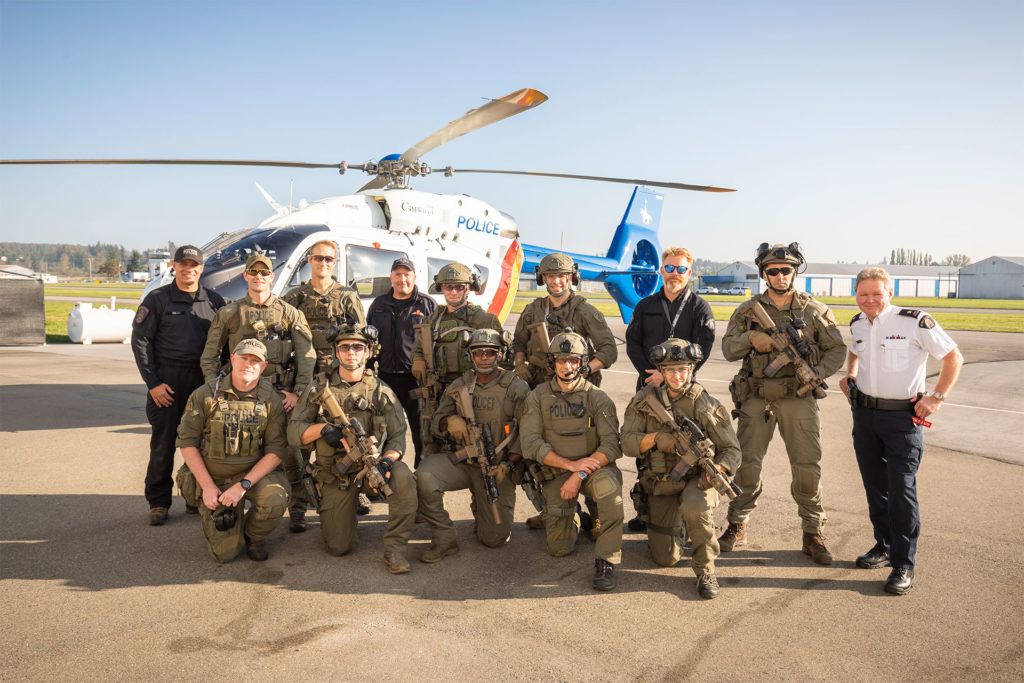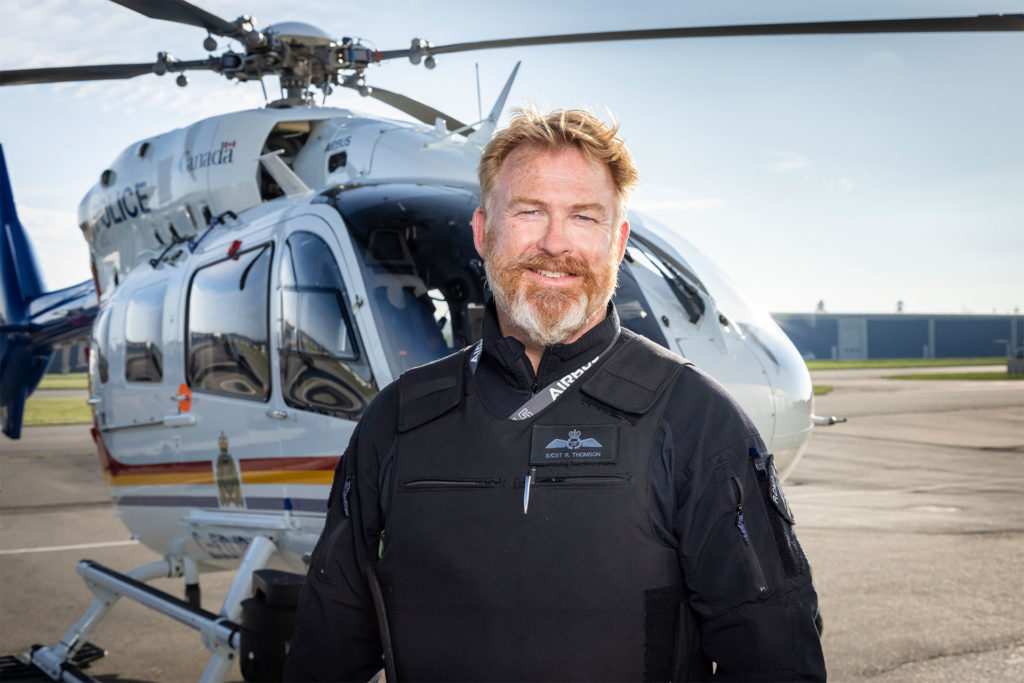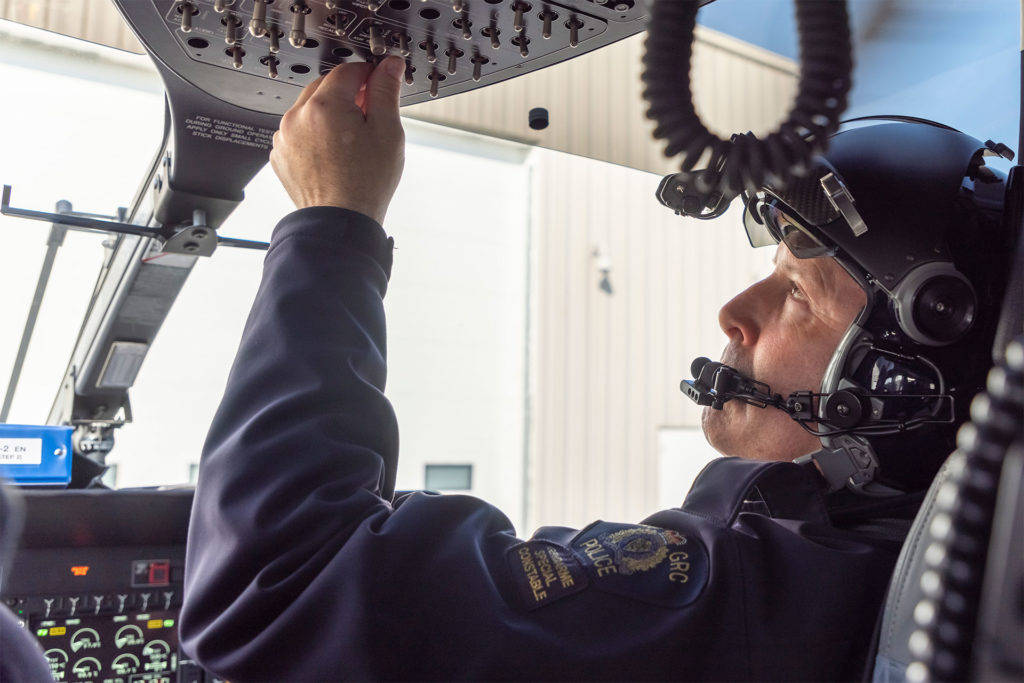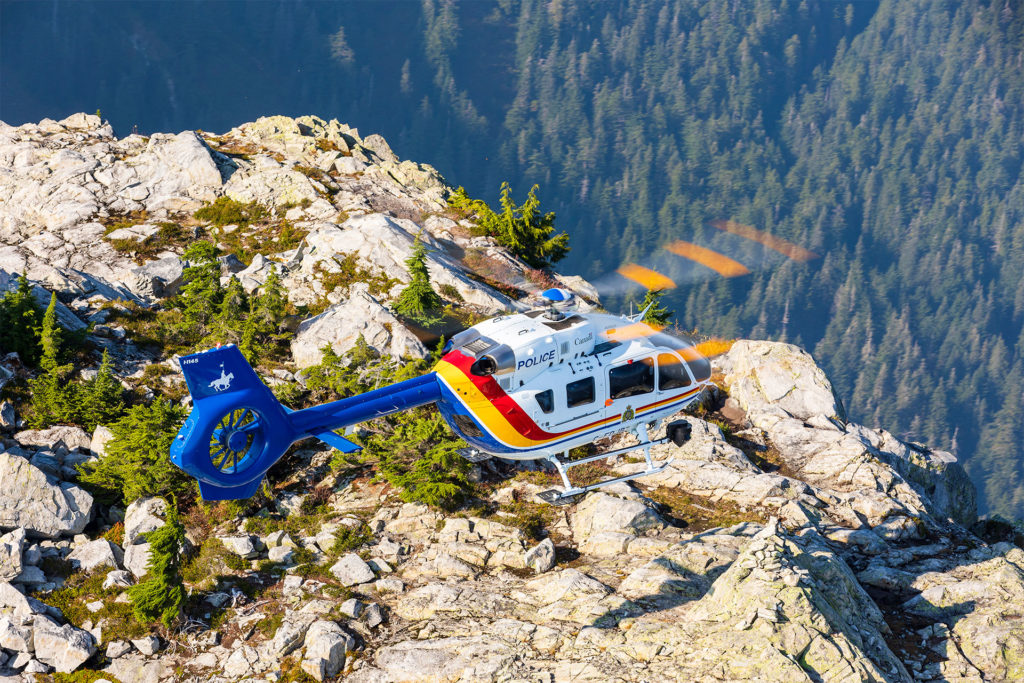Photos by Heath Moffatt
Catching bad guys from the air can be quite different than catching bad guys on the ground — at least in British Columbia.
“We never arrest anyone,” said Cpl. Curtis Brassington. “In my 15 years, we’ve landed, and I’ve arrested one person. And I think I’m the only one who’s done that.”
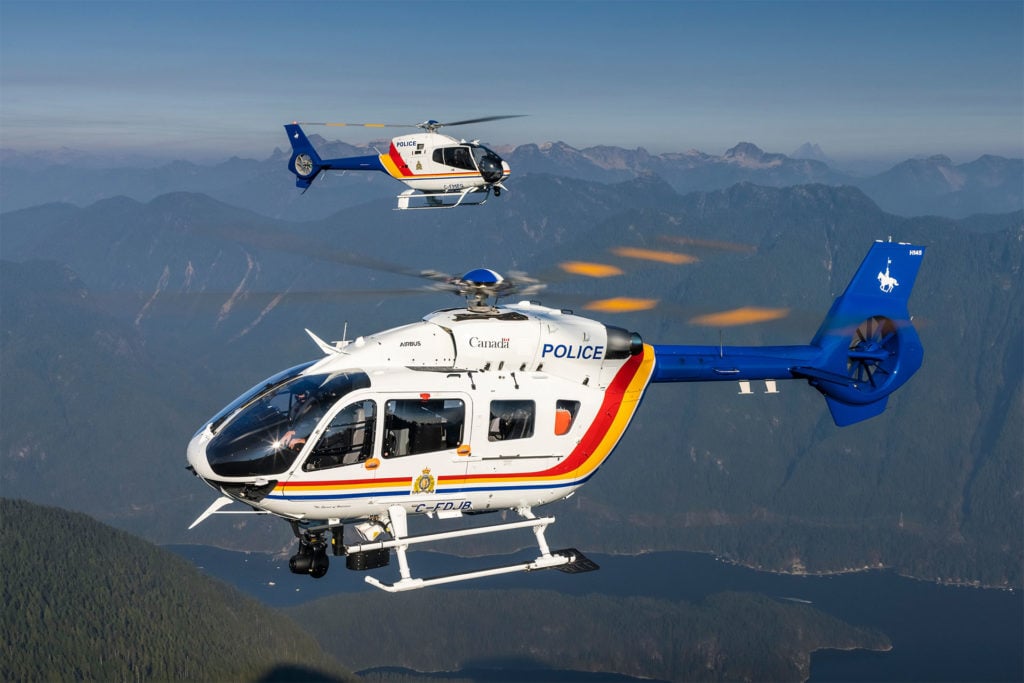
As senior tactical flight officer (TFO) at the Royal Canadian Mounted Police (RCMP) air services base in the Vancouver region, Brassington explained that he was tracking a person who had stolen a boat and had stopped on an island.
“I said, ‘let’s get him now, since it’s going to take a long time for everyone else to get here.’”
But that’s the exception, given the realities of “quickly” putting a helicopter on the ground. “You’re giving [a suspect] a five-minute lead time as you start circling to find a nice spot to land. It’s not practical,” he added.
Most of his thousands of hours in the air have been spent in the RCMP’s Airbus H120s, operating the sensor suite while coordinating with his pilot and police on the ground.
Now, Brassington and his colleagues have a bigger and newer aircraft to fly the RCMP’s missions, one that is a true utility vehicle.
A new Airbus
It’s been two years since Canada’s first Airbus H145 helicopter showed up in the RCMP’s aviation stable in British Columbia.
The twin-engine light utility machine is based at Langley Regional Airport southeast of downtown Vancouver, sharing the hangar with two Airbus H120s, all providing air support for Canada’s westernmost province.

A massive, magnificent territory, B.C. stretches from the Pacific coast to the Rocky Mountains, and from the United States border to the north at the 60th parallel.
With spectacular lakes, mountains, and high prairie, B.C. lives up to its moniker of “Super, Natural British Columbia.” Over half of its five million residents live in the area known as the Lower Mainland, centered on the province’s largest city, Vancouver.
Policing this huge, varied area is the responsibility of the Royal Canadian Mounted Police, a federal service. The RCMP is contracted to operate as the provincial police force by the Government of B.C., augmenting the various municipal law enforcement services in urban areas.
Aviation has long been a key component of the RCMP’s operation in B.C. — known as “E” Division — covering the province from six bases, with a mix of a dozen fixed-wing aircraft and helicopters that include the Pilatus PC-12, Quest Kodiak and Airbus AS350 B3.
Having the right machine for the job was a priority for the RCMP when it was looking for a new utility helicopter to replace an AS350 B3 that crashed, with the tragic loss of its pilot, in 2012.
Then-Inspector Nigel Bushe was officer in charge for air services in B.C. when the procurement process for the new aircraft was underway. He retired from the RCMP in November 2020, after 35 years of service.
“We’re the biggest division in the country. A third of the RCMP is in B.C.,” said Bushe, in an interview with Valor. “It was a consultative, collaborative process to get to what we needed, and we talked with [our] units around the province.”
Three bids came back when the proposal for the new helicopter was put out to industry, Bushe said, and “the RCMP’s analysis of the bids concluded that the H145 exceeded our requirements in many of the criteria.”
The flying pickup
“Where the H120 is sort of our sports car, and the AStars at our other bases are our pickup trucks like an F-150, this is our F-350 or F-450,” explained Special Constable Roger Thomson, base manager and pilot, making the comparison to the largest Ford pickups.
“It’s that much bigger,” Thomson added. “The interior is huge, with clamshell doors at the back, and all the seats can come out and be moved around. It’s just a big truck.”
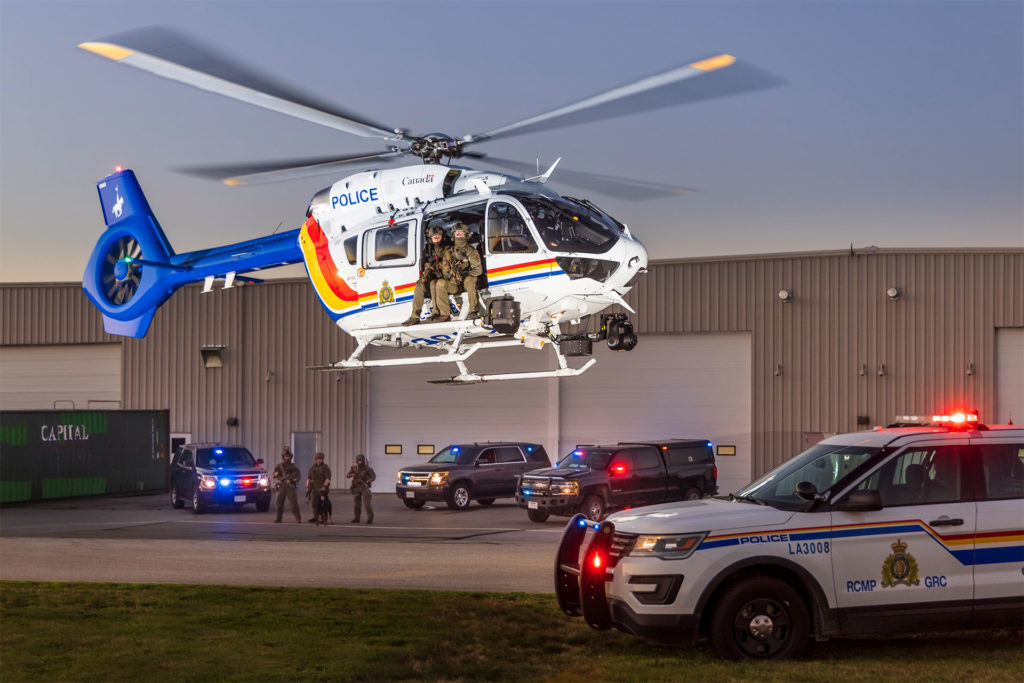
While the H120s generally work with the police on the ground during regular patrols over the Lower Mainland, the H145 is tasked with a wide variety of missions — servicing mountaintop radio repeaters, transporting emergency response teams, search-and-rescue, as well as law enforcement duties that include patrol of the Canada-United States border.
This flying “big truck” came from Airbus kitted out with the equipment needed to fulfill its multi-mission mandate.
The RCMP’s machine joins the worldwide fleet of 150 H145s operating in airborne law enforcement, of the 1,460 units that have been delivered.
The helicopter that gleams in the RCMP’s spotless hangar traces its roots back to the early 1990s MBB/Kawasaki BK117 C1. This latest version — which officially carries the BK117 D2 type designation — includes technology that would have only been dreamed of 30 years ago.
The machine’s two Safran Helicopter Engines Arriel 2E turbines are equipped with full-authority digital engine control (FADEC), which integrates with the H145’s state-of-the-art Helionix avionics suite.
Designed to give pilots increased situational and operational awareness as well as a reduced workload, Helionix interfaces with the helicopter’s dual-duplex, four-axis autopilot.
Thomson, who has over 10,000 hours in 10 different helicopter types, explained that in normal operations he will lift off manually, and then hand control over to the autopilot.
“It reduces the pilot’s workload,” Thomson said. “Your attention can be elsewhere, rather than just trying to hold an altitude, for example. It’s sophisticated, and with all the computer systems it’s a really simple aircraft to fly. The 145 is the easiest helicopter I’ve ever flown.”
Mission-specific equipment on the H145 includes a TrakkaBeam A800 searchlight, FLIR forward-looking infrared imaging sensor, night vision goggles, radio equipment, and an internal long range fuel tank system.
Airbus quotes a 145-knot cruise speed for the H145, but Thomson said that “Air 5” — the helicopter’s RCMP ID — is draggy with “a lot of stuff hanging off of it,” so it cruises at around 120 knots.

Endurance for the H145 matches the RCMP’s H120s at around 2.5 hours, depending on the mission and fuel load.
Eye in the sky
The high-definition camera system installed in the H145 is “the biggest, longest range camera in the RCMP. We can [see] up to about 10 kilometers [6.2 miles],” said Thomson.
The imagery from the camera system can be fed to one of the multipurpose displays in the front avionics panel, but it’s the crew’s tactical flight officer who normally interprets the visuals on a large monitor in a workstation behind the pilot.
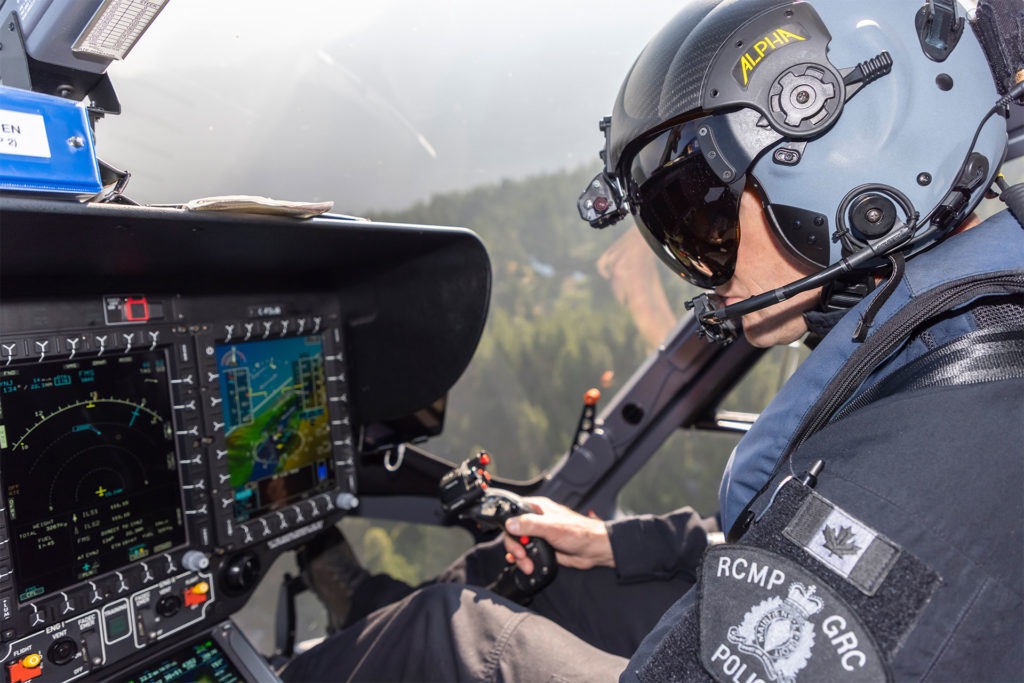
Brassington described the camera system in the H145 in a quintessentially Canadian way.
“If I ask you to watch a hockey game on your old 19-inch RCA and then watch a hockey game on your 55-inch HD flatscreen, which will be better?” Brassington asked. “The H120 has 20-year-old gear and we’d love to get it upgraded, but it still does everything — you can still see the game — but you do get more with the newer system [on the H145]. It’s simply better — better optics, better range, better clarity.”
The H145’s twin engines will bring an increased level of safety on flights over dangerous terrain in B.C.’s rugged interior, looking deep into valleys when on a search mission.
Brassington admits with all the technology that’s available onboard, sometimes the “Mk 1” human eyeball is the best surveillance equipment — as long as the observers are well trained.
“A lot of what we do isn’t with the camera,” he said. “Trying to find something with the camera is like trying to… if I put a grain of salt on a table, and gave you a straw to look through, it’s going to take you forever, whereas if you use your naked eye, you can probably spot it in a minute.”
Teamwork and clear communications between the pilot and TFO are essential on every mission. In the H120, the TFO sits beside the pilot, making it easy to see hand signals, or for either crew member to intuitively pick up on each other’s cues.
“The pilot’s job is to get the TFO to where he needs to be. I position the helicopter so he can see what he needs,” said Thomson.
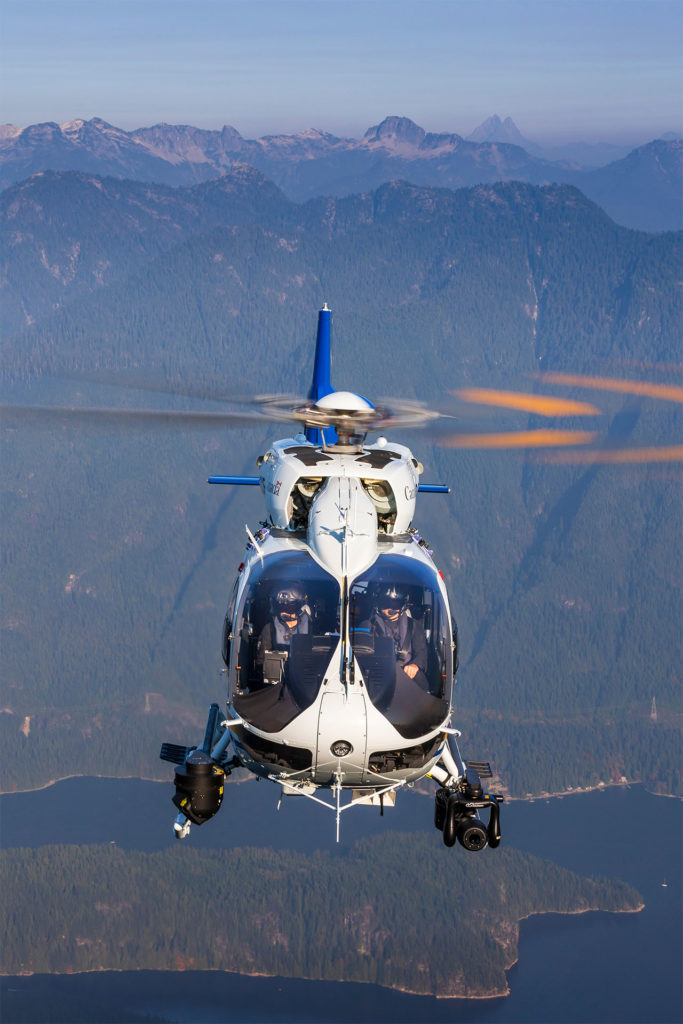
With the move of the TFO to the workstation in the H145’s cabin, the TFO and the pilot can’t see each other, and have to rely on the intercom to communicate.
“Being in the back of the 145, our communication skills have to be that much better. We’ve been able to hone them for years in the 120, so it’s actually been fairly easy, but very enlightening,” said Brassington.
With the camera imagery on one of the forward multi-function displays, the pilot has the same view as the TFO, but needs context for the target.
“I’d say, ‘Roger, at our 10 o’clock’ and he’d look at the monitor. I’d have the camera nice and wide so he could pick out a landmark he could reference, then I’d zoom in,” explained Brassington.
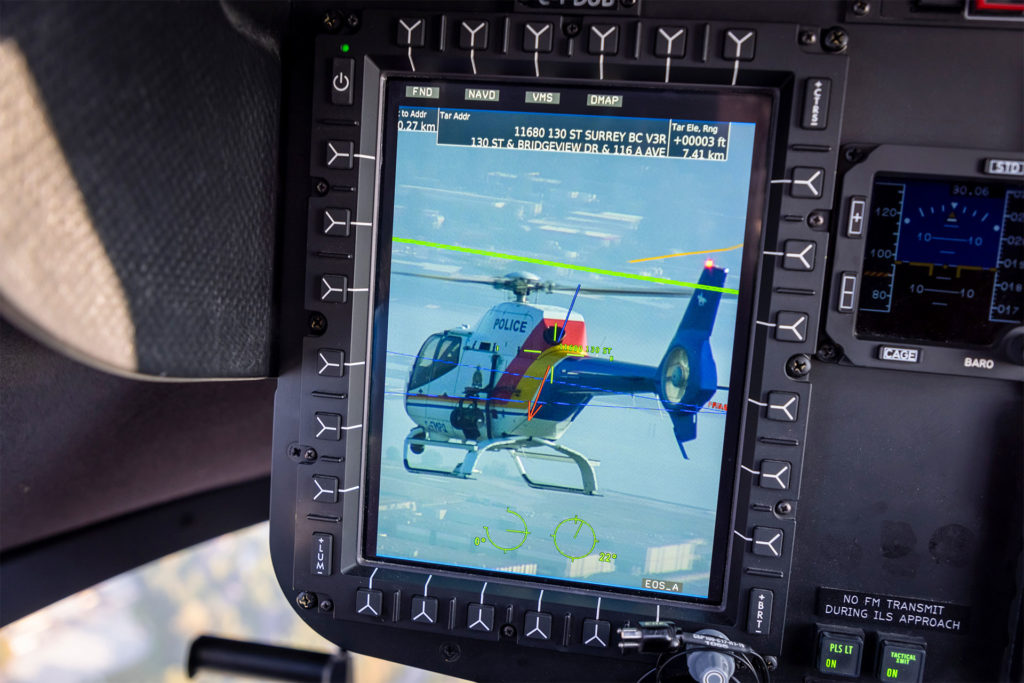
“Our flying style also has to be different with the 145,” added Thomson. “Now we’re both on the same side in a bigger aircraft, we’re louder, we have to get further away, and we have to get higher so we’re not spotted. His TFO station is directly behind me. We’re looking out the same side, but we have to fly differently. We had to learn how to fly a different orbit — in the 120 we fly counter-clockwise, we’re doing clockwise now because of where we’re sitting.”
Drawing on experience
On missions, pilots must be completely comfortable with maneuvering the machine, a skill that generally comes only with extensive flying experience, and the RCMP looks to the civilian market for high-time candidates.
A pilot must have no fewer than 3,000 hours as pilot-in-command to be considered for an RCMP position, but according to Thomson, the pilots hired in the past 10 years have all had at least 6,000 or 7,000 hours.

“We need that experience. We don’t need a new guy trying to fight the helicopter and fight crime,” he said.
Brassington agreed. “I’d rather fly with a pilot who has 20 years of flying experience and is learning about policing, than a cop who has 20 years of policing and is learning about flying.”
The Langley team of five pilots, four TFOs, and two maintenance engineers keep the H120s flying about 1,200 hours per year, with the H145 airborne between 300 and 500 hours annually.
The flight time of the twin will naturally increase when the machine reaches full operation, adding the H145’s integrated winch system. The winch can be used for police operations, such as deployment of the RCMP’s Emergency Response and Underwater Recovery Teams, as well as for search-and-rescue.
The approval to begin winch operations has been moving through the required policy processes, and although Thomson had hoped to deploy the H145 with its full capability in 2020, the approval may be delayed into “the spring.”
“Once we get the ability to hoist and long line, then we’ll be 95 percent there. And there are some other things that our emergency response team would like to do, like rappelling or fast roping.”
With the H145’s avionics suite and four-axis autopilot, Thomson can command the machine to automatically hold a hover, simplifying external operations.
He said that once winch approval is granted, “we can be up and running fairly quickly, with two weeks of training and then practice.”
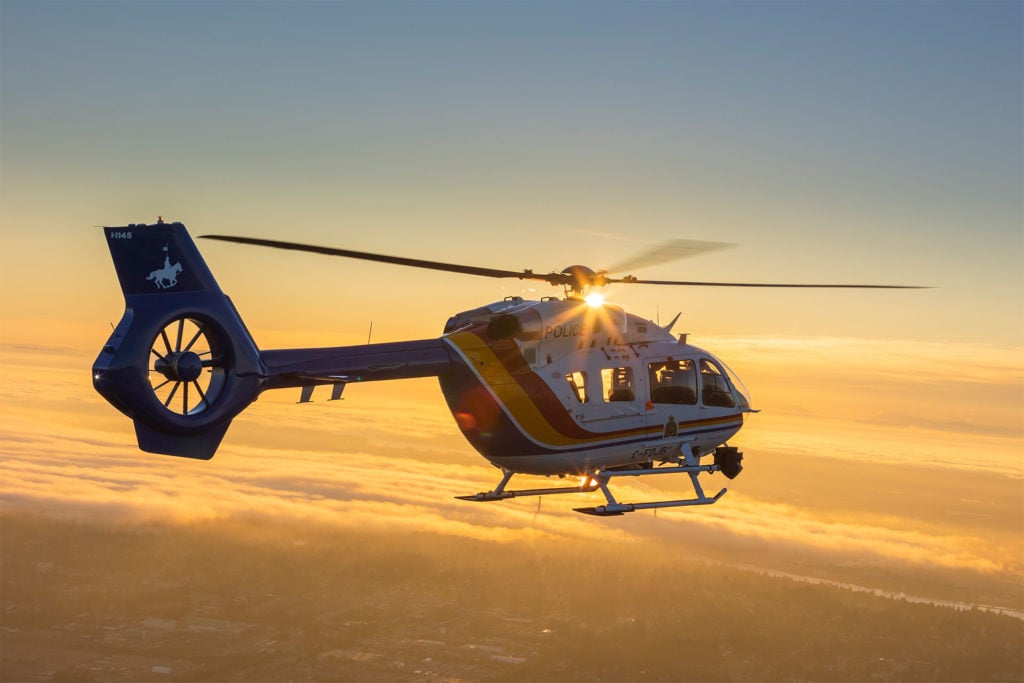
The helicopter is instrument flight rules certified, but the approval to operate in instrument conditions is also still in the works. It’s something that Thomson looks at as being the “last five percent” of the helicopter’s operational rollout, but one that is essential to safely deploying the H145 throughout the province.
Bushe summarized the situation: “We’ve encountered several delays, but we’re moving towards utilizing the expertise and experience of our pilots, along with the full capabilities of the helicopter.”






